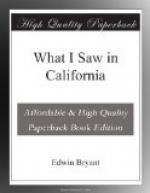The botany and flora of California are rich, and will hereafter form a fruitful field of discovery to the naturalist. There are numerous plants reported to possess extraordinary medical virtues. The “soap-plant” (amole) is one which appears to be among the most serviceable. The root, which is the saponaceous portion of the plant, resembles the onion, but possesses the quality of cleansing linen equal to any “oleic soap” manufactured by my friends Cornwall and Brother, of Louisville, Ky.
There is another plant in high estimation with the Californians, called canchalagua, which is held by them as an antidote for all the diseases to which they are subject, but in particular for cases of fever and ague. For purifying the blood, and regulating the system, I think it surpasses all the medicinal herbs that have been brought into notice, and it must become, in time, one of the most important articles in the practice of medicine. In the season for flowers, which is generally during the months of May and June, its pretty pink-coloured blossoms form a conspicuous display in the great variety which adorn the fields of California.
The water-power in California is ample for any required mill purposes. Timber for lumber is not so convenient as is desirable. There is, however, a sufficiency of it, which, when improvements are made, will be more accessible. The timber on the Sierra Nevada, the most magnificent in the world, cannot be, at present, available. The evergreen oak, that grows generally in the valleys, is not valuable, except for fuel. But in the canadas of the hills, and at several places on the coast, particularly at Santa Cruz and Bodega, there is an amount of pine and fir, adapted for lumber, that will not be consumed for a long time.
The religion of the Californians is the Roman Catholic, and, like the people of all Roman Catholic countries, they appear to be devotedly attached to the forms of their religion. That there are some, I will not say how many, paganish grafts upon the laws, formalities, and ceremonies, as prescribed by the “Holy Church Universal” for its government and observance, is undeniable, but these probably do not materially affect the system. The females, I noticed, were nearly all devoutly attached to their religious institutions. I have seen, on festival or saint days, the entire floor of a church occupied by pious women, with their children, kneeling in devout worship, and chanting with much fervency some dismal hymn appertaining to the service. There are but few of the Jesuit fathers who established the missions now remaining in the country. The services are performed at several of the churches that I visited, by native Indians, educated by the padres previous to their expulsion by the Mexican government.
CHAPTER XVI.
OFFICIAL REPORT ON THE GOLD MINES.
The following is an official account of a visit paid to the gold region in July by Colonel Mason, who had been appointed to the military command in California, and made his report to the authorities at Washington. It is dated from head-quarters at Monterey, August 17, 1848.




